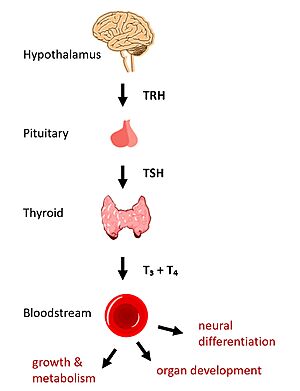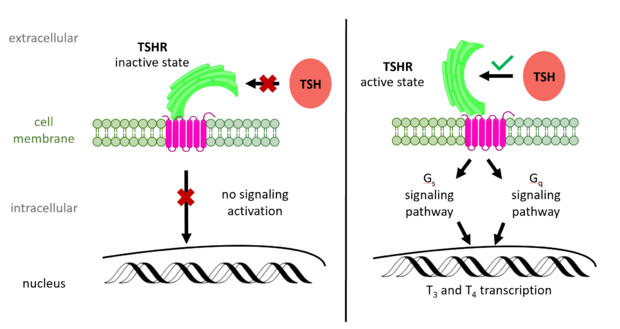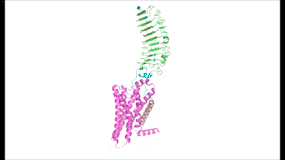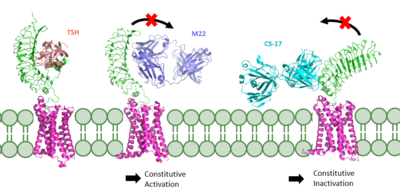Sandbox Reserved 1774
From Proteopedia
(Difference between revisions)
| Line 45: | Line 45: | ||
== Ligand Binding == | == Ligand Binding == | ||
=== Binding of Thyroid Stimulating Hormone to TSHR=== | === Binding of Thyroid Stimulating Hormone to TSHR=== | ||
| - | The thyroid stimulating hormone <scene name='95/952703/Tsh-ecd/3'>binds to the extracellular domain</scene> by complementary shape<ref name="Duan" />. The ECD is curved and compliments the curvature of TSH similar to how a baseball fits into a glove. Several key ionic interactions between the TSH and TSHR also occur in the <scene name='95/952703/Seatbelt/3'>seat belt region of TSH</scene>. The seatbelt region is located in the beta subunit of the TSH. <scene name='95/952703/Tsh-tshr_itxn-3/4'>The first ionic interaction</scene> is Glu118 from TSH and Lys58 from the ECD.<scene name='95/952703/Tsh-tshr_itxn-2/3'>The second interaction</scene> is between Asp111 from the TSH and Lys209 from the ECD. These interactions form salt bridges between the ECD and the TSH which allows for specificity of binding for TSH to TSHR <ref name="Duan" /> | + | The thyroid stimulating hormone <scene name='95/952703/Tsh-ecd/3'>binds to the extracellular domain</scene> by complementary shape<ref name="Duan" />. The ECD is curved and compliments the curvature of TSH similar to how a baseball fits into a glove. Several key ionic interactions between the TSH and TSHR also occur in the <scene name='95/952703/Seatbelt/3'>seat belt region of TSH</scene>. The seatbelt region is located in the beta subunit of the TSH. <scene name='95/952703/Tsh-tshr_itxn-3/4'>The first ionic interaction</scene> is Glu118 from TSH and Lys58 from the ECD.<scene name='95/952703/Tsh-tshr_itxn-2/3'>The second interaction</scene> is between Asp111 from the TSH and Lys209 from the ECD. These interactions form salt bridges between the ECD and the TSH which allows for specificity of binding for TSH to TSHR <ref name="Duan" /><ref name="Faust" />. |
| - | Other key interactions that | + | Other key interactions that determine the specificity of binding are <scene name='95/952703/Tsh-tshr_itxn-4/3'>polar and nonpolar interactions</scene> between TSH and helix 1. Helix 1 contains several polar residues that interact with surrounding nonpolar residues like Leu62 and Phe17. Positively charged Arg54 was also seen to interact with Helix 1. These interactions increase the activation potency and help activate the push and pull mechanism of the hinge region <ref name="Duan" /><ref name="Faust" />. |
=== Ligand Regulation of Signaling Activation === | === Ligand Regulation of Signaling Activation === | ||
| - | [[Image:conformation1.png|400px|right|thumb|'''Figure 2''' TSHR in active and inactive binding states. '''Left''' is TSH bound to TSHR. '''Middle''' is M22 bound to TSHR. '''Right''' is CS-17 bound to TSHR.]] | + | [[Image:conformation1.png|400px|right|thumb|'''Figure 2''' TSHR in active and inactive binding states. '''Left''' is TSH bound to TSHR ([https://www.rcsb.org/structure/7T9I 7T9I]). '''Middle''' is M22 bound to TSHR ([https://www.rcsb.org/structure/7T9N 7T9N]). '''Right''' is CS-17 bound to TSHR ([https://www.rcsb.org/structure/7T9M 7T9M]).]] |
The interactions between the ligand and the receptor have important consequences for disease states. In the image shown to the right are three different states of TSHR. The left-most structure is TSH bound to TSHR in the upright active conformation. In the middle receptor-ligand pair, [https://www.creativebiolabs.net/Anti-TSHR-Antibody-24960.htm M22] is bound to TSHR is in the upright state and prevents transition to the down state because of steric clash with the membrane. This conformation causes constitutive activation and the elevated levels of thyroid hormones which are found in a person with Grave's disease. On the right-most side is [https://pubmed.ncbi.nlm.nih.gov/19299457/ CS-17] bound to the TSHR. In contrast to TSH and M22 binding, CS-17 binds and locks TSHR in the down, inactive conformation. This prevents the signaling cascade to translation and causes constitutive inactivation <ref name="Faust" />. | The interactions between the ligand and the receptor have important consequences for disease states. In the image shown to the right are three different states of TSHR. The left-most structure is TSH bound to TSHR in the upright active conformation. In the middle receptor-ligand pair, [https://www.creativebiolabs.net/Anti-TSHR-Antibody-24960.htm M22] is bound to TSHR is in the upright state and prevents transition to the down state because of steric clash with the membrane. This conformation causes constitutive activation and the elevated levels of thyroid hormones which are found in a person with Grave's disease. On the right-most side is [https://pubmed.ncbi.nlm.nih.gov/19299457/ CS-17] bound to the TSHR. In contrast to TSH and M22 binding, CS-17 binds and locks TSHR in the down, inactive conformation. This prevents the signaling cascade to translation and causes constitutive inactivation <ref name="Faust" />. | ||
Revision as of 16:06, 15 April 2023
| This Sandbox is Reserved from February 27 through August 31, 2023 for use in the course CH462 Biochemistry II taught by R. Jeremy Johnson at the Butler University, Indianapolis, USA. This reservation includes Sandbox Reserved 1765 through Sandbox Reserved 1795. |
To get started:
More help: Help:Editing |
| |||||||||||




